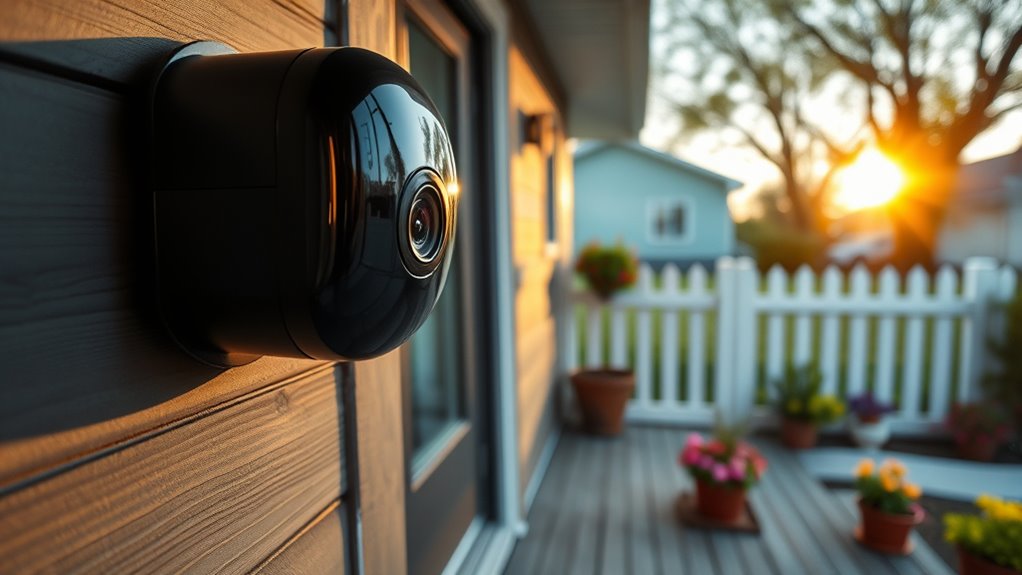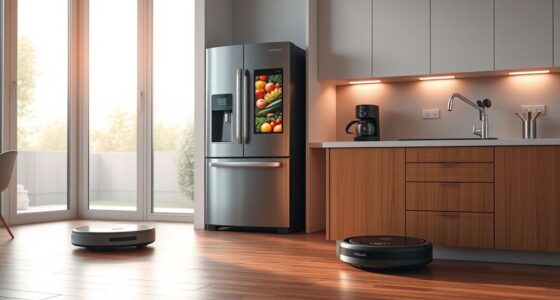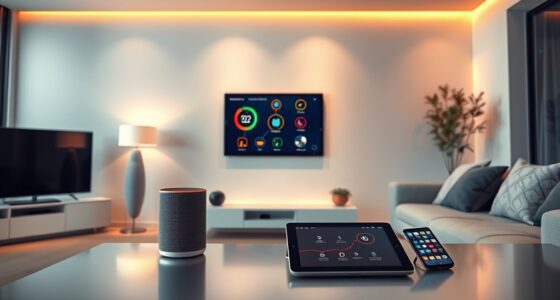Doorbell cameras can boost your home security by capturing video, audio, and facial data, but they also raise privacy concerns. They might record beyond your property, including public areas or neighbors’ spaces, which can lead to legal issues or community conflicts. To protect privacy, position cameras thoughtfully, inform visitors, and use secure storage methods. If you want to learn how to balance safety with respect for everyone’s privacy, keep exploring these important considerations.
Key Takeaways
- Ensure camera placement respects neighbors’ privacy and avoids public spaces or private areas beyond your property.
- Clearly post signage indicating doorbell camera use to inform visitors and passersby.
- Use secure, encrypted storage and strong access controls to protect recorded footage from unauthorized access.
- Comply with local laws regarding audio recording, public recording, and privacy expectations for doorbell cameras.
- Regularly review and adjust camera settings and privacy zones to balance security needs with respecting privacy rights.
How Doorbell Cameras Function and What They Record

Doorbell cameras are designed to monitor and record activity at your front door, providing real-time video footage whenever someone approaches. They often include audio capture, allowing you to hear conversations or sounds near your door, which can be useful for identifying visitors or potential threats. Many models also incorporate facial recognition technology, enabling the camera to identify familiar faces and alert you when someone known or unknown is nearby. This combination of video, audio, and facial recognition helps enhance security but also raises privacy concerns. The cameras continuously record what happens outside your home, storing footage that can be reviewed later. Understanding exactly what these devices capture and how they do it is essential for managing your privacy and security effectively. Additionally, being aware of community engagement practices can help you stay informed about how local residents share and handle security footage.
Common Data Collection Practices and Storage Methods

To effectively manage your privacy, it’s important to understand how data from doorbell cameras is collected and stored. Most companies follow common practices, including:
- Using data encryption to protect footage during transfer and storage.
- Collecting data only with your user consent, often through terms of service agreements.
- Storing recordings on secure cloud servers or local devices, depending on the system.
- Limiting access to data, ensuring only authorized users can view footage.
- Implementing privacy policies that specify data handling and user rights.
These methods aim to safeguard your information but also highlight the importance of reading privacy policies. Knowing how your data is handled helps you make informed decisions about your privacy and the security of your family’s footage.
Privacy Risks Associated With Doorbell Cameras
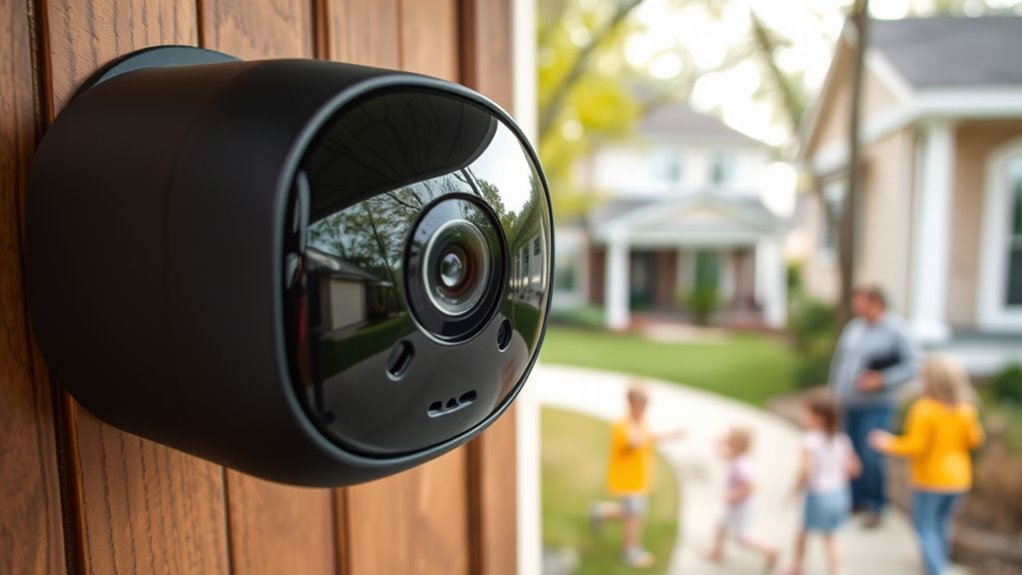
While doorbell cameras offer convenience and security, they also pose significant privacy risks. You might unknowingly compromise doorbell privacy if your camera captures footage beyond your property, such as public sidewalks or neighboring yards. This can lead to unintended recording of passersby or neighbors, raising ethical concerns about consent. Without clear camera consent, people may feel their privacy is violated, especially if recordings are shared or stored without permission. Additionally, hackers can gain access to your camera feeds, risking exposure of sensitive moments or personal information. These risks highlight the importance of understanding how your doorbell camera operates and ensuring it’s configured to respect privacy boundaries. Being aware of these privacy risks helps you make informed decisions to protect both your family’s security and others’ rights. Properly monitoring your camera settings can help mitigate some of these issues.
Legal Considerations and Regulations for Recording Public Spaces
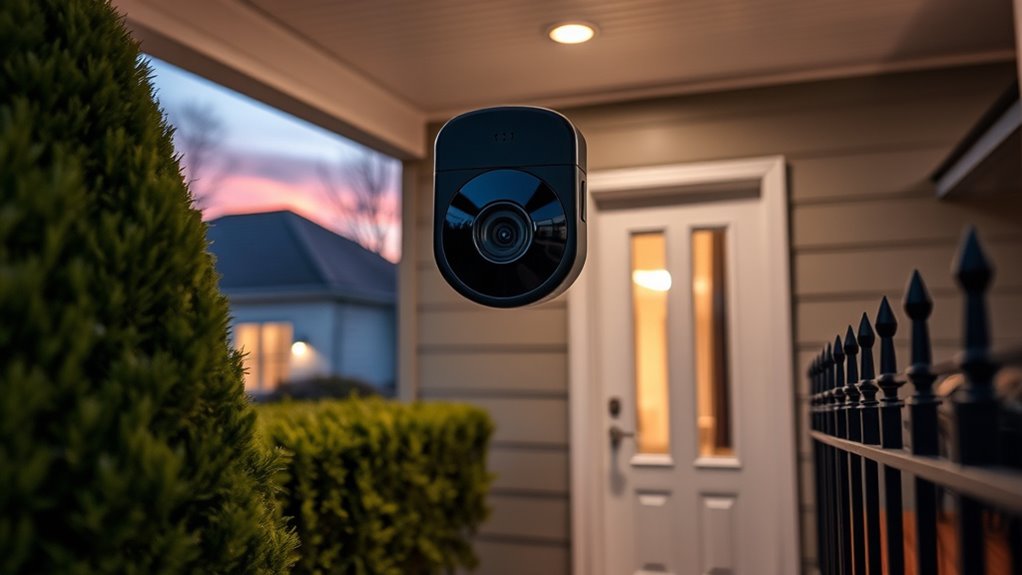
Understanding the legal landscape surrounding doorbell cameras is key to ensuring you stay within boundaries when recording in public spaces. To maintain legal compliance and respect privacy regulations, consider these points:
Understanding doorbell camera laws helps you record legally while respecting privacy.
- Know that recording public areas is generally legal, but capturing private properties or individuals without consent may breach privacy laws.
- Avoid intentionally recording beyond your property boundaries or areas where people have a reasonable expectation of privacy.
- Be aware that some regions have specific restrictions on audio recording, requiring clear notice or consent.
- Stay updated on local laws, as regulations regarding surveillance and public recording can change frequently.
- Remember that self watering plant pots are designed to prevent over-monitoring or intrusive surveillance, emphasizing the importance of respecting privacy boundaries.
Best Practices for Positioning and Using Doorbell Cameras
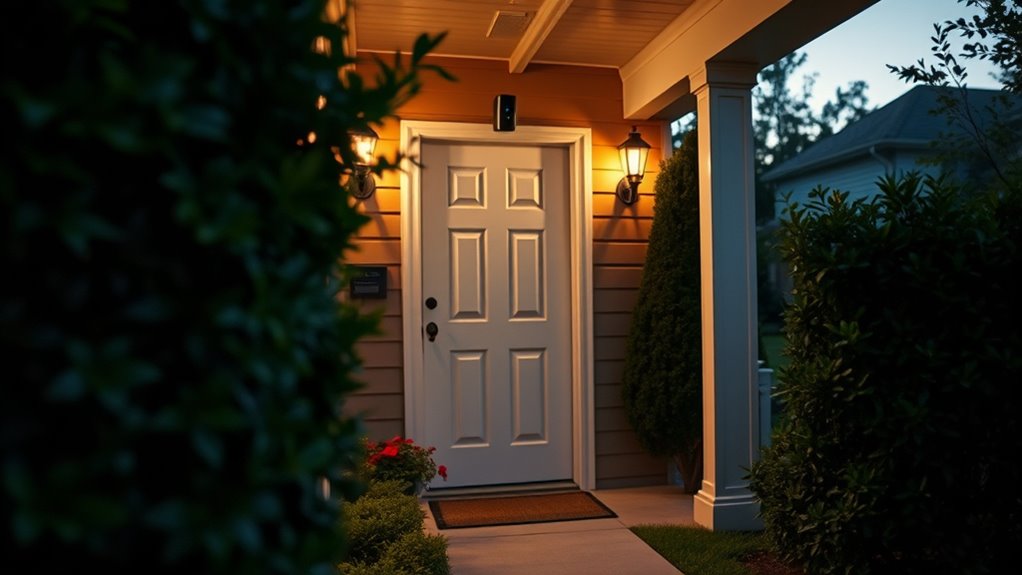
To get the most out of your doorbell camera while respecting privacy, you need to consider where and how you position it. Think about ideal placement to cover key areas without invading neighbors’ privacy, and adjust your privacy zones accordingly. Decide whether continuous recording or motion-based recording suits your needs best to balance security and privacy concerns. Additionally, understanding the cost factors involved can help you choose a system that fits your budget and security needs.
Optimal Placement Strategies
Choosing the right spot for your doorbell camera is essential to maximize security and coverage. Proper placement guarantees effective monitoring without compromising doorbell aesthetics or device installation integrity. Consider these strategies:
- Position the camera at chest level for clear facial and package visibility.
- Mount it near your doorframe, avoiding obstructions like bushes or lights.
- Ensure the camera points toward your driveway or walkway for comprehensive coverage.
- Use a stable surface to prevent movement that could blur footage or disrupt device installation.
- Optimal positioning techniques help ensure your doorbell camera functions effectively and remains unobtrusive.
Avoid placing the camera too high or too low, which can reduce image clarity. Also, consider lighting conditions to prevent glare or shadows. Thoughtful placement balances security with visual appeal, making your doorbell both functional and aesthetically pleasing.
Privacy Zone Configuration
Configuring privacy zones on your doorbell camera helps you protect your neighbors’ privacy while maintaining security. Proper privacy zone configuration involves selecting specific areas within the camera’s view to mask or exclude from recording, a technique called zone masking. By adjusting these zones, you prevent the camera from capturing private spaces like neighbors’ yards or windows, reducing privacy concerns. When setting up, identify sensitive areas and carefully draw privacy zones to cover them without obstructing important entry points. Regularly review and update your zone masking settings to ensure they remain effective as surroundings change. Clear privacy zone setup helps balance your security needs with respect for others’ privacy, fostering trust and compliance with privacy laws. Additionally, understanding how to properly utilize eye patch benefits can contribute to overall well-being, especially during long periods of outdoor or screen exposure.
Continuous vs. Motion Recording
When deciding between continuous and motion-based recording modes for your doorbell camera, understanding their impact on security and privacy is essential. Continuous recording offers constant video quality, capturing every detail but may raise privacy concerns and require more storage. Motion recording conserves space and focuses on relevant events, making it easier to review footage. To optimize your setup:
- Use user interfaces that allow easy switch between modes.
- Adjust motion sensitivity to prevent false triggers.
- Choose cameras with high video quality for clear recordings.
- Regularly review stored footage to ensure privacy zones are respected.
- Remember that implementing storage management strategies can help balance security needs with privacy considerations.
Balancing these options helps you protect your property without compromising privacy. Consider your household’s needs to select the best recording mode, ensuring security while maintaining control over your video footage.
How to Protect Your Family’s Privacy While Using Doorbell Cameras

To protect your family’s privacy while using doorbell cameras, you need to take deliberate steps to control who can access your footage and how it’s stored. First, set strong, unique passwords for your device and update them regularly to prevent unauthorized access. Enable two-factor authentication if available. Be aware of your camera’s settings to ensure it only records what’s necessary, reducing unnecessary exposure. Maintain camera awareness by regularly reviewing footage and permissions, removing access for anyone who no longer needs it. Additionally, choose secure storage options, such as encrypted cloud services or local storage, to safeguard your recordings. Implementing AI in security can help identify unusual activity and alert you to potential breaches, further protecting your privacy. Prioritizing family privacy means being intentional about access and storage, helping you use doorbell cameras responsibly without compromising your loved ones’ security.
Understanding Consent and Privacy Expectations for Visitors

You should guarantee visitors know they’re being recorded by posting clear signage near your door. Respect their privacy rights by understanding what they’re entitled to and how they expect to be treated. Open communication helps everyone feel comfortable and aware of the camera’s presence. Additionally, considering cultural sensitivity can help ensure that privacy expectations are respected across diverse communities.
Visitor Privacy Rights
Visitors have a right to understand how their images and movements are being recorded and used when they encounter doorbell cameras. Respecting their privacy means being transparent about data collection and their consent. Here are key points to contemplate:
- Clearly communicate whether recordings are stored or shared, respecting neighborhood aesthetics and avoiding intrusive camera aesthetics.
- Inform visitors if their images might be used for security, marketing, or other purposes.
- Limit camera angles to focus on your property, reducing unnecessary capturing of public or neighboring areas.
- Be mindful of how your doorbell camera impacts visitor comfort and privacy expectations, maintaining a welcoming neighborhood environment.
Clear Camera Signage
Clear signage indicating the presence of doorbell cameras is essential for guaranteeing visitors understand that their images are being recorded. Effective doorbell signage should be prominently displayed, clearly stating that the area is under surveillance. Including privacy notices with your signage helps communicate your commitment to respecting privacy rights and informs visitors about how their data is handled. This transparency fosters trust and ensures everyone knows what to expect when approaching your home. Make sure the signs are easy to read and visible from a distance. By providing clear camera signage and privacy notices, you demonstrate your respect for visitors’ privacy while complying with legal and ethical standards. This proactive approach helps prevent misunderstandings and promotes respectful interactions.
Managing Data Sharing and Cloud Storage Security
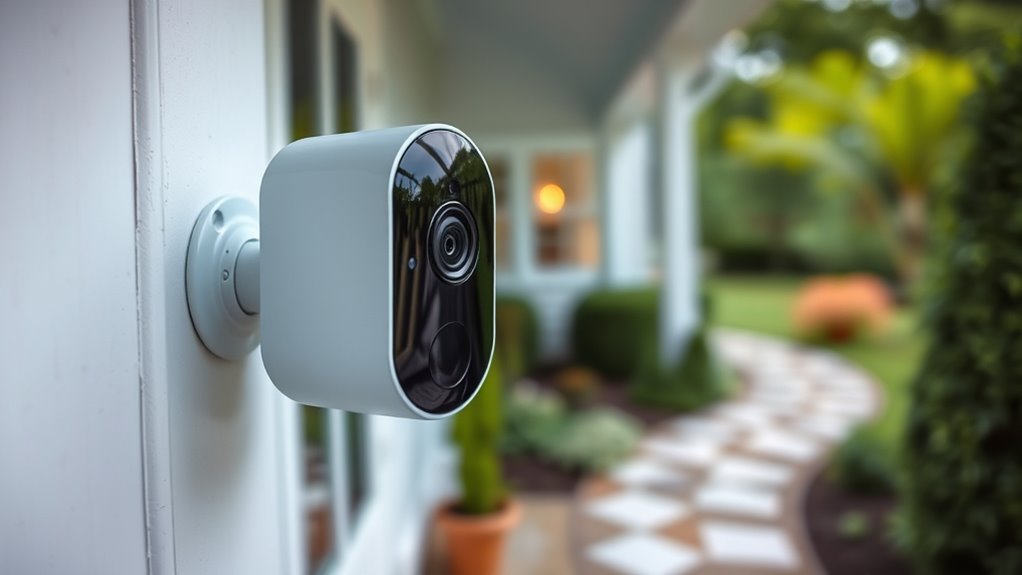
Managing data sharing and cloud storage security is essential to protecting your privacy with doorbell cameras. To keep your information safe, focus on these key steps:
- Enable data encryption to scramble footage, making it unreadable if accessed without permission.
- Use strong, unique passwords and activate user authentication to verify your identity before accessing stored data.
- Review privacy settings regularly to control who can view or share your footage.
- Choose reputable cloud providers that implement robust security measures and transparent data policies.
Tips for Communicating With Neighbors About Surveillance Devices
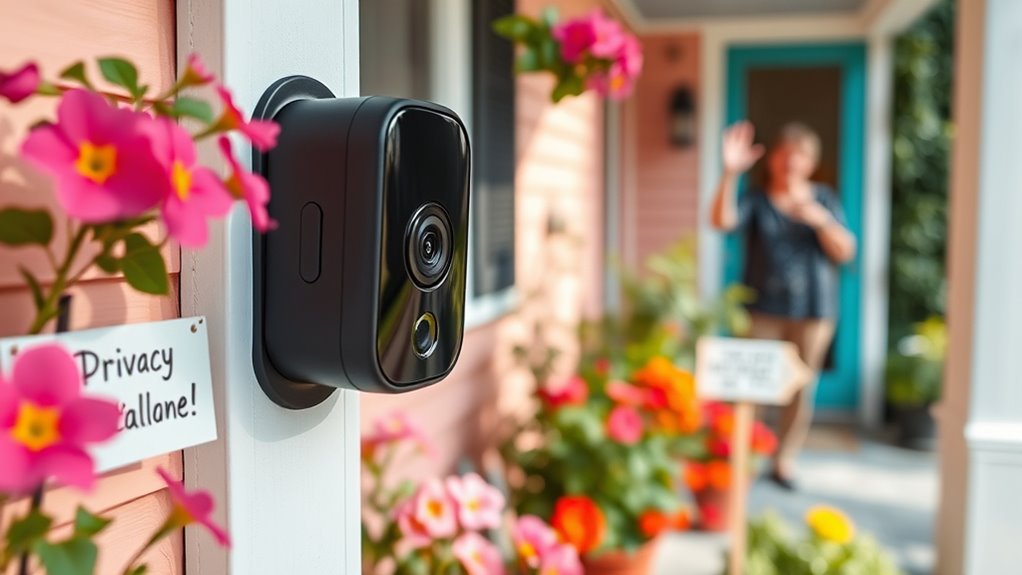
Open communication with your neighbors is key when installing surveillance devices like doorbell cameras. Engaging in community discussions fosters trust and helps manage privacy negotiations upfront. Approach your neighbors with transparency about your intentions, explaining how the camera is positioned and what areas it covers. Listen to their concerns and be willing to make adjustments if needed, such as repositioning the device or limiting its field of view. Building community engagement reduces misunderstandings and potential conflicts. Remember, proactive dialogue can prevent privacy issues before they escalate. Respecting your neighbors’ privacy rights while ensuring your home’s security benefits everyone. Clear, respectful communication creates a positive environment where surveillance devices are viewed as a shared safety resource rather than an invasion of privacy.
Balancing Security Benefits With Respect for Privacy

You want your doorbell camera to enhance security without infringing on your neighbors’ privacy. Setting clear monitoring limits and respecting privacy boundaries helps achieve this balance. By being mindful of what your camera captures, you protect both security and trust in your community.
Monitoring Limits and Practices
While doorbell cameras can enhance security, establishing clear boundaries to protect privacy is essential. To do this effectively, consider these monitoring limits and practices:
- Use video encryption to safeguard your footage from hacking attempts.
- Implement data anonymization techniques so that recorded data doesn’t reveal identities unnecessarily.
- Limit live viewing to essential times to reduce unnecessary surveillance.
- Regularly review and delete outdated footage to prevent data accumulation.
Respecting Privacy Boundaries
Balancing the security benefits of doorbell cameras with respect for privacy requires thoughtful boundaries and responsible use. You should limit access to video footage and ensure it’s stored securely, using data encryption to protect sensitive data. Respect neighbors’ privacy by positioning cameras to avoid capturing private areas like windows or backyard spaces. Regularly review footage and delete unnecessary recordings. Communicate transparently with family members and visitors about camera use. Establish clear policies on who can view footage and how it’s shared.
| Privacy Tips | Security Measures |
|---|---|
| Avoid capturing private spaces | Use data encryption for footage |
| Inform neighbors and visitors | Limit access to authorized users |
| Regularly delete unnecessary footage | Position cameras thoughtfully |
| Communicate policies clearly | Review footage periodically |
Frequently Asked Questions
Can Doorbell Cameras Record Audio Without Consent?
No, doorbell cameras typically can’t record audio without consent due to legal restrictions. In many areas, laws require that all parties involved in a conversation give permission before recording audio, which falls under wiretapping laws. If you plan to use a doorbell camera with audio, you should inform visitors about the recording. Always check your local laws to ensure you’re complying with consent requirements for audio recording.
How Long Is Footage Typically Stored by Companies?
Think of your footage as a story in a bottle—how long it stays in the sea depends on the company’s data retention policy. Typically, companies store footage for 30 to 60 days, but some may keep it longer or shorter, depending on their storage duration policies. Always check your provider’s privacy settings to understand their data retention practices, ensuring your privacy remains protected in this digital tide.
Are There Differences in Privacy Laws Across States?
Yes, there are differences in privacy laws across states because of varying state regulations and privacy variances. You should check your state’s specific laws, as some states have stricter rules on data collection and surveillance, while others are more lenient. These differences affect how companies handle doorbell camera footage and your privacy rights. Staying informed helps you understand what protections you have and how your data may be used or shared.
How Can I Disable or Limit Recording Features?
You can disable or limit recording features by adjusting your doorbell camera’s privacy settings, turning off motion detection, or scheduling recording times. Think of privacy settings as a gatekeeper—controlling what’s recorded and when. Always review and modify recording permissions in the app to guarantee your privacy preferences are met. This way, you stay in control, allowing recordings only when you want them, and protect your family’s privacy effortlessly.
What Are the Best Ways to Inform Visitors About Surveillance?
You should use clear signage to inform visitors about your surveillance. Place visitor notification signs prominently near your doorbell camera, ensuring they’re easily visible. Follow signage best practices by using simple language, bold fonts, and universal symbols to communicate that the area is monitored. This approach respects privacy, deters unwelcome visitors, and keeps everyone informed, fostering transparency and trust with guests and neighbors alike.
Conclusion
Just like Orwell warned us about constant surveillance, it’s essential to respect privacy even as you protect your home. By understanding how doorbell cameras work and following best practices, you can strike a balance between security and respect. Stay informed, communicate openly with neighbors, and manage your data responsibly. Remember, safeguarding your home shouldn’t come at the cost of becoming the Big Brother of your neighborhood. Privacy is a shared, precious right—protect it wisely.
